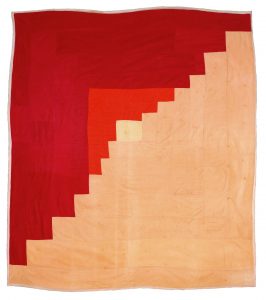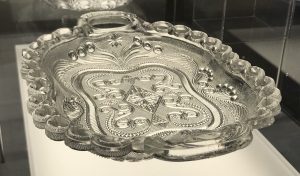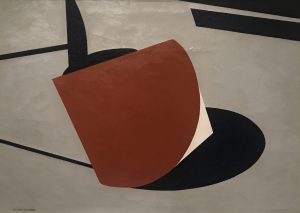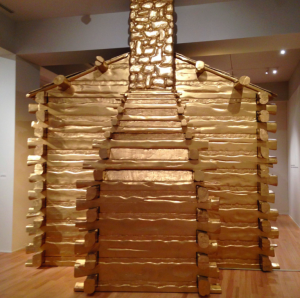American Labor Day was first celebrated in New York City on September 5, 1882, as a political demonstration and picnic planned by an estimated 10,000 members of the Central Labor Union in what amounted to a one-day strike. By 1894, the first Monday in September was set aside as a federal holiday, defined today as a celebration of the achievements and contributions of American workers. Listed here are five works in NOMA’s collection that honor the ingenuity and contributions of the American workforce across time and in all manner of occupations.
NOMA and the Besthoff Sculpture Garden will be open on Labor Day, Monday, September 7, for special holiday hours from 10 am to 3 pm.

Clementine Hunter, Harvesting Gourds near the African House and Wash Day Near Ghana House, Melrose Plantation, 1959, Oil on board, 73 x 66 ½ inches, New Orleans, Museum of Art, Museum purchase, C. Heiderich Art Purchase Fund, 2018.8
Harvesting Gourds near the African House and Wash Day Near Ghana House, Melrose Plantation
Clementine Hunter (1886/87–1988) is well remembered as one of Louisiana’s most influential artists. Born in 1887, Hunter spent the majority of her life as a field laborer and domestic living and working on the Melrose Plantation near Natchitoches. Hunter did not begin her work as an artist until the 1940s when she began painting at night, attempting to document her life and that of other African Americans on plantations in the area. Harvesting Gourds near the African House and Wash Day Near Ghana House, Melrose Plantation was designed as a site-specific mural for an outbuilding at Melroe. The work is a prime example of Hunter’s unique approach to narrative arrangements. The painting is also a wonderful example of her connection with the sociopolitical landscape of the southern United States, offering viewers an insight into the lives of an underrepresented working class.

Qunnie Pettway (American, 1943–2010), “Bricklayer” Variation quilt, 1975. Corduroy, 82 x 72 in., Museum purchase, and gift of the Souls Grown Deep Foundation from the William S. Arnett Collection, 2017.170, © Estate of Qunnie Pettway/Artists Rights Society (ARS), New York, Photograph by Stephen Pitkin/Pitkin Studio/Art Resource, NY
“Bricklayer” Variation quilt from the exhibition The Quilts of Gee’s Bend
The tradition of quilting in Gee’s Bend, a remote community in Alabama, began in the early nineteenth century when the area was a part of a cotton plantation. Enslaved women used scraps of fabric to create bedsheets with patterns, often in a free-spirited manner with no traditional pattern. Born of resourcefulness and thrift, Gee’s Bend quilts have come to be recognized as masterpieces of African American craft. This “Bricklayer” variation quilt was created in 1975 by Qunnie Pettaway as a part of the Freedom Quilting Bee, a cooperative organized by civil rights workers to create an industry for women in Gee’s Bend and nearby communities as incomes from agricultural work began to lag. The tradition of quilting has been passed down through generations of Gee’s Bend women helping the community overcome oppression, isolation, and economic struggle.
Wharf Objects, Santa Barbara
Ralston Crawford (1906–1978) is best known for his abstract representations of urban life and industry, along with a photographic career that included documentation of New Orleans’s music scene in the mid-twentieth century. Shipyards, factories, and bridges are featured prominently in his paintings. Of his approach to creating art, Crawford said, “I don’t feel obligated to reveal the forms. They may be totally absent to the viewer of the work, or even to myself, but what is there, however abstract, grows out of something I have seen. I make pictures.” His painting Wharf Objects, Santa Barbara was part of several studies of maritime industry along the Pacific Coast. Crawford’s father was a cargo ship captain and Crawford also spent time working on cargo ships in Latin America.

Attributed to Boston & Sandwich Glass Company (Massachusetts, 1825–1888), Tray, 1830–1840, Pressed glass, Museum purchase, George S. Frierson, Jr. Fund, 89.284
“Lacy” Chain Border Tray
Glassmaking is largely considered to be the first American industry, beginning in 1607 with the settlement of Jamestown, Virginia. While the early American glass industry struggled to gain international recognition, the craft quickly became America’s largest export. In 1825, Deming Jarvis opened the Boston & Sandwich Glass Company in Sandwich, Massachusetts, and by 1855, the company perfected a technique for pressing out imperfections in the surface. This “Lacy” Chain Border Tray is one of the pieces created by the glass company using this new technique.
America
Will Ryman’s America is a must-see for any NOMA visit. The large sculpture is a gilded reconstruction of Abraham Lincon’s log-cabin birthplace appropriated to provide a commentary on American capitalism and consumerism. The cabin’s interior is a mosaic made from an array of industrial and consumer products from the largest industries since the Civil War. The materials include corn, railroad spikes, pharmaceuticals, electronics, and bullets. The floor is layered with slave shackles. The melange symbolically represents the array of industries, innovations, and institutions that America was built upon.
NOMA intern Victoria L. McClure contributed to this list.

